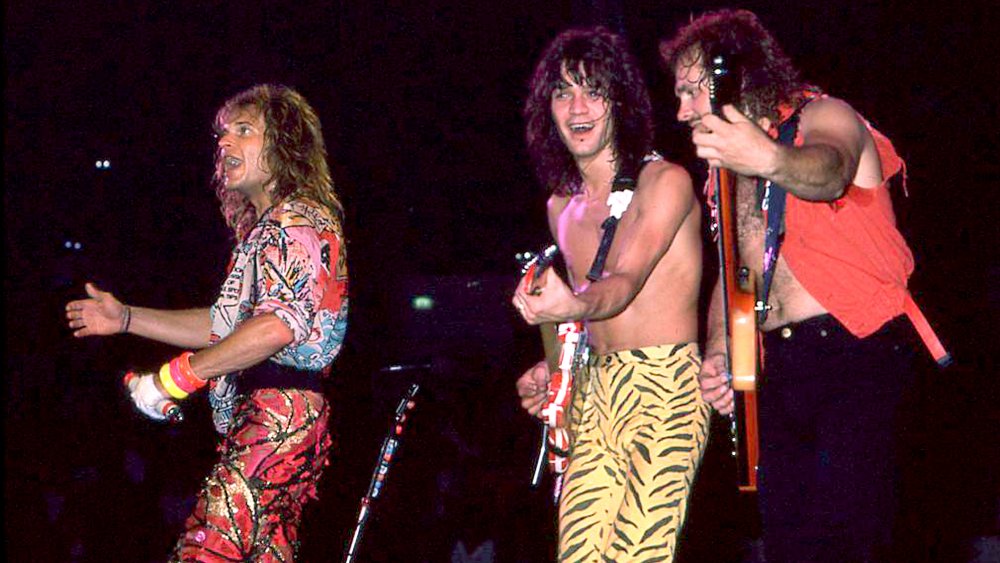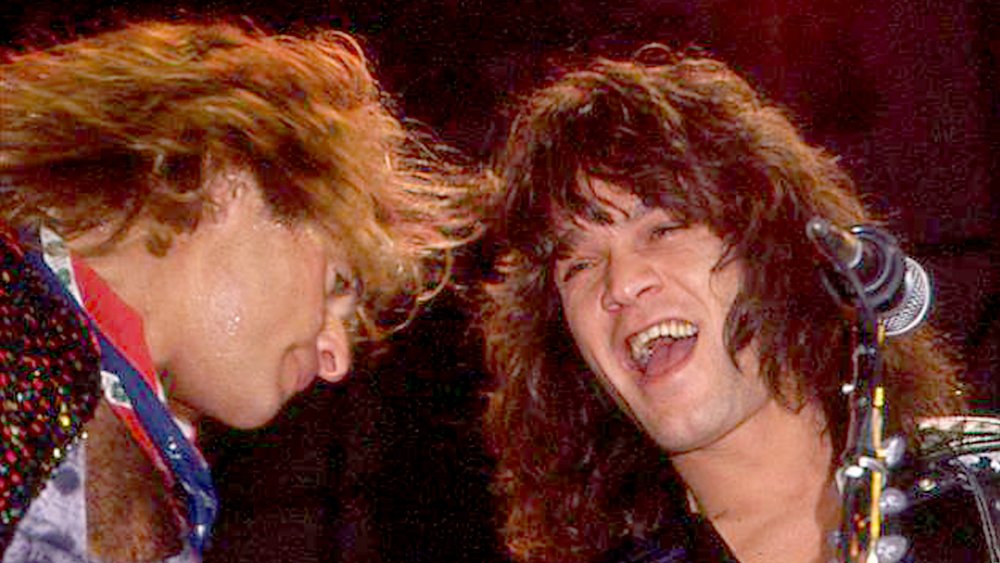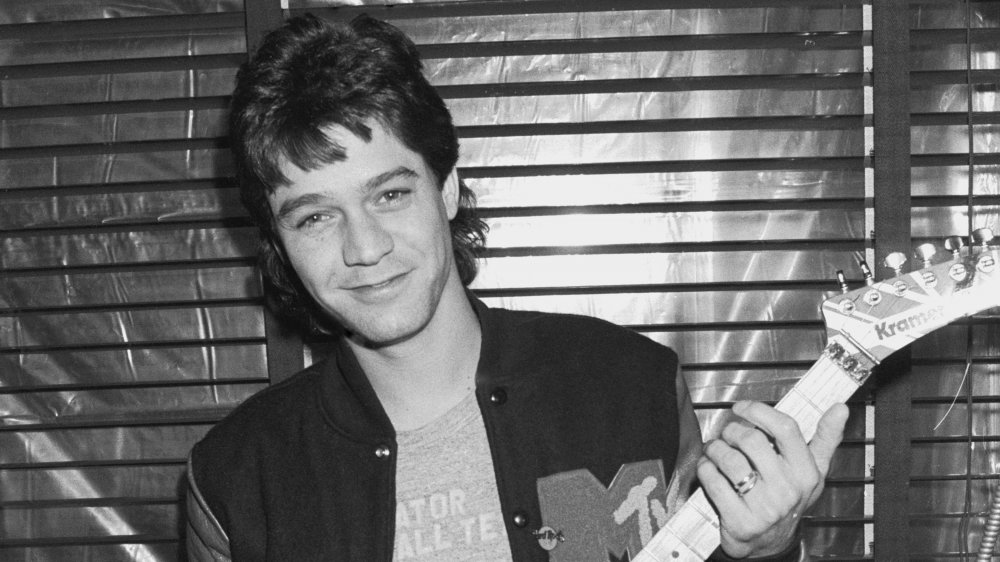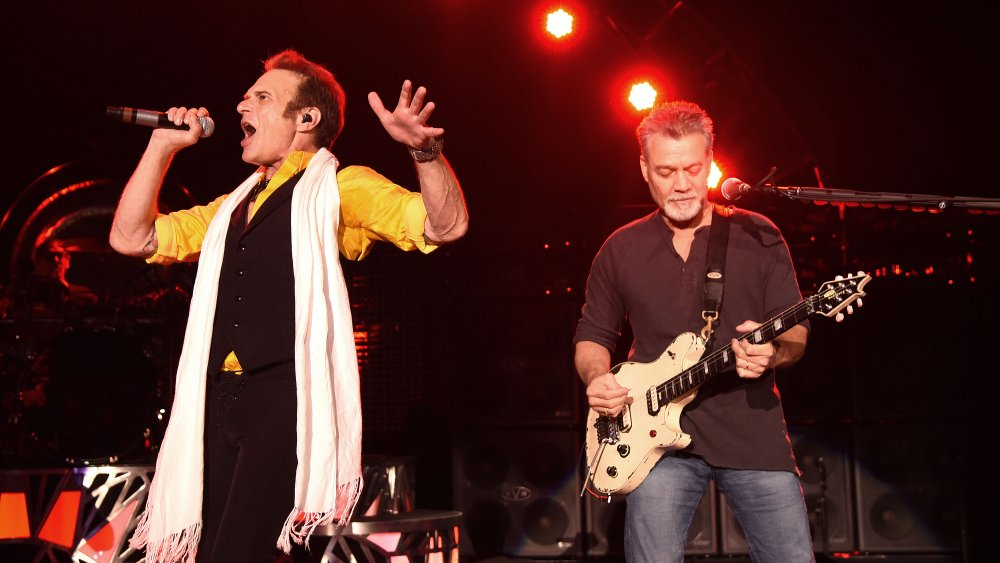How Van Halen's Best Album Signaled A Breakup
As we celebrate the life of Eddie Van Halen, it's hard to avoid the endless drama and ever-changing lineups that existed alongside the ground- and record-breaking success of his band, Van Halen. Perhaps the most notorious Van Halen situation was the recurring disappearance and reappearance of lead singer David Lee Roth. David and Eddie had a famously fractious relationship; the lead singer always wanted to be the rock star at the center of everyone's attention, while the guitarist was more about the music than the trappings of fame. In a 2015 Billboard interview, Van Halen admitted that he had used cocaine and alcohol, but "alcohol and cocaine were private things to me. I would use them for work. The blow keeps you awake and the alcohol lowers your inhibitions."
Tensions ramped up between the two during the making of the 1980 album Women and Children First, particularly when it came to shooting the album cover and inset photos with provocative fashion photographer Helmut Newton. Per Cuepoint, posted at Medium, the Van Halen brothers "viewed this whole episode as an effort by Roth to hijack the band's image for the new album" and disliked working with Newton. Another photographer ended up shooting the cover and insets, but a Newton portrait of Roth "bare-chested ... on his knees, his hands chained above his head to a cyclone fence" was made into a poster that was tucked into the first million copies of the album. The rest of the band was displeased.
'How you really make a Van Halen record'
Despite the dust-up over the photography for Women and Children First, the band seemed to know that it had something special going on and continued, creating two more albums before their most iconic of all, 1984's 1984. By the time the band was ready to record, Eddie Van Halen had finished constructing his personal music studio with engineer Donn Landee, which he named 5150 Studios. Eddie was unhappy with the number of cover songs on the 1982 album Diver Down as well as the influence of producer Ted Templeman, per Ultimate Classic Rock. He "wanted more control" and to "show Ted that we could make a great record without any cover tunes and do it our way." According to Van Halen, 1984 was "me showing Ted how you really make a Van Halen record."
Eddie was the driving force behind the single "Jump," which is probably Van Halen's most beloved, well-known song, as well as their only number one hit. Eddie was particularly keen on the song's synthesizers, which David Lee Roth disliked. According to Van Halen, Roth "said that I was a guitar hero and I shouldn't be playing keyboards."
Eddie Van Halen was in the driver's seat for 1984
Roth then later tried to respond by "enforc[ing] his personality on the band's videos," wanting to make a video for "Jump" featuring him "in a wide range of rock-star moments," reports Ultimate Classic Rock. It didn't happen. Roth directed the video, but it simply features the band performing onstage. Despite the success of the album, video, and single, Roth was unhappy, as "the success of 1984 put Eddie Van Halen in the driving seat, and left Roth less convinced that he wanted to sit alongside."
Roth left Van Halen after a 1985 "summit meeting" in which he announced that he "couldn't work with you guys anymore." Eddie responded by announcing, "I'm looking for a new lead singer ... it's weird that it's over. Twelve years of my life putting up with his bull...t." Little did he know that it was far from over and that he and Roth would spend many more years breaking up and getting back together.
The many frontmen of Van Halen
Per Ultimate Classic Rock, Sammy Hagar replaced David Lee Roth and stayed with Van Halen for 11 years, during which the band had its first number one album on Billboard with 1986's 5150, followed by the successful OU812 and For Unlawful Carnal Knowledge. The Van Hagar era came to an end when Hagar "either quit or was fired from Van Halen."
The band teased a Roth reunion at the 1996 MTV Video Music Awards, but he only returned for two new songs for 1996's Best of Volume 1. For a brief moment it looked like Mitch Malloy would step up to the mic, but instead Extreme's Gary Cherone took the lead singing position for two years and one album, 1998's Van Halen III. After Cherone was let go, Sammy Hagar came back for his own two song reunion in 2004 as well as a tour. The tour went badly, and Hagar was out again. The final version of Van Halen came together in 2007, with David Lee Roth once again getting back behind the mic and Eddie's son Wolfgang Van Halen stepping into the bassist role that had previously belonged to Michael Anthony since 1974. The band recorded the album A Different Kind of Truth in 2014 and toured for the last time in 2015.



